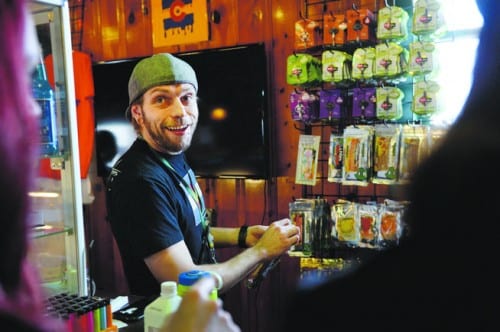Medical pot patients are six times more likely to ingest their cannabis via vaporizers — and four times more likely to eat marijuana-infused edibles — than their recreational counterparts, according to a new RAND Drug Policy Research Center study published today in the journal Addiction.
Medical pot patients also spend an average of $48 per month on cannabis — four times more than recreational users’ average monthly pot budget of $12, according to the study.
The RAND study surveyed 1,994 people in four western states in October 2013, a transition period when Colorado and Washington had legalized recreational marijuana (though the sales wouldn’t start until a couple months later) and Oregon and New Mexico had medical cannabis programs.
Vaping: Check it
For the pot tourists: This Colorado mountain resort town has a rent-a-vape option for Volcanos
Concentrates 101: How to consume them — dabbing, vaping and more
The controversy: Is vaping still the ‘dumbest thing ever,’ or is resistance futile?
NEW: Get podcasts of The Cannabist Show.
Subscribe to our newsletter here.
Watch The Cannabist Show.
While only 3 percent of the surveyed recreational users vaporize marijuana and 8 percent consume edibles, 18 percent of their medical counterparts vaporize and 32 percent eat edibles, according to the study, signifying a potential shift away from smoked cannabis.
For those preferring to smoke marijuana, 93 percent of recreational users and 78 percent of medical patients said that was their chosen method of ingestion.
“People who use marijuana for medical purposes were much more likely to eat or vaporize than those using for recreational purposes, maybe because they’re being exposed to new products through dispensaries,” Rosalie Pacula, the study’s lead author and a senior economist at RAND, told The Cannabist.
The study’s findings on how people obtained their marijuana the last time they used it — “got it from a dispensary,” “obtained from a dealer” or “got it free” — are some of the most fascinating statistics in the report.
Medical patients rely on dispensaries (32 percent) and dealers (23 percent) much more than recreational users, 2 percent of whom buy from dispensaries and 4 percent from dealers. More than half of recreational users say they got the pot for free (58 percent) or paid a friend (29 percent) when they last got high, while those figures for medical patients (13 and 16 percent, respectively) were significantly lower.

RAND’s Pacula was surprised to only see 32 percent of medical patients utilizing dispensaries: “It’s surprisingly small, and that might be driven by Washington, which didn’t have the dispensary system Colorado did at the time,” she said.
Those growing their own marijuana at home, 3 percent of recreational users and 5 percent of medical patients, are in the minority.
Medical patients also “report a higher amount (in grams) consumed and spend more money per month than recreational users,” according to the study. But the average age of a patient’s first medical marijuana use was 32 years old — nearly double that of a recreational user’s age of first use, 18 years old, according to the study.
The National Institute on Drug Abuse funded the study.
The study also found that around 86 percent of people who reported using cannabis for medical purposes also use the drug recreationally — and that recreational users are much more likely to use cannabis and alcohol simultaneously.
“About 17 percent of recreational marijuana users reported they usually used cannabis and alcohol together, while such use was reported by fewer than 3 percent of those who said they use marijuana for both recreational and medical purposes,” researchers wrote in press materials, noting that the percentages were lower than they expected.
“When you’re using something for a specific medical purpose,” RAND’s Pacula said, “your goal isn’t to get high. Your goal is to deal with the symptom. This finding is very consistent with another study RAND did years ago, where people seeking medical recommendations were claiming they wanted to use marijuana in lieu of alcohol or opioids. They felt it was a better alternative for their symptoms.”
Researchers noted that their survey included a high percentage of female and relatively few younger respondents, “which could skew the results.” But they added that their findings on several general questions about overall cannabis use were similar to previous surveys.
